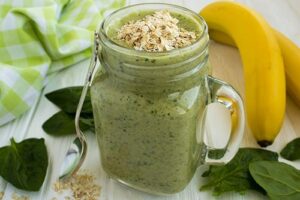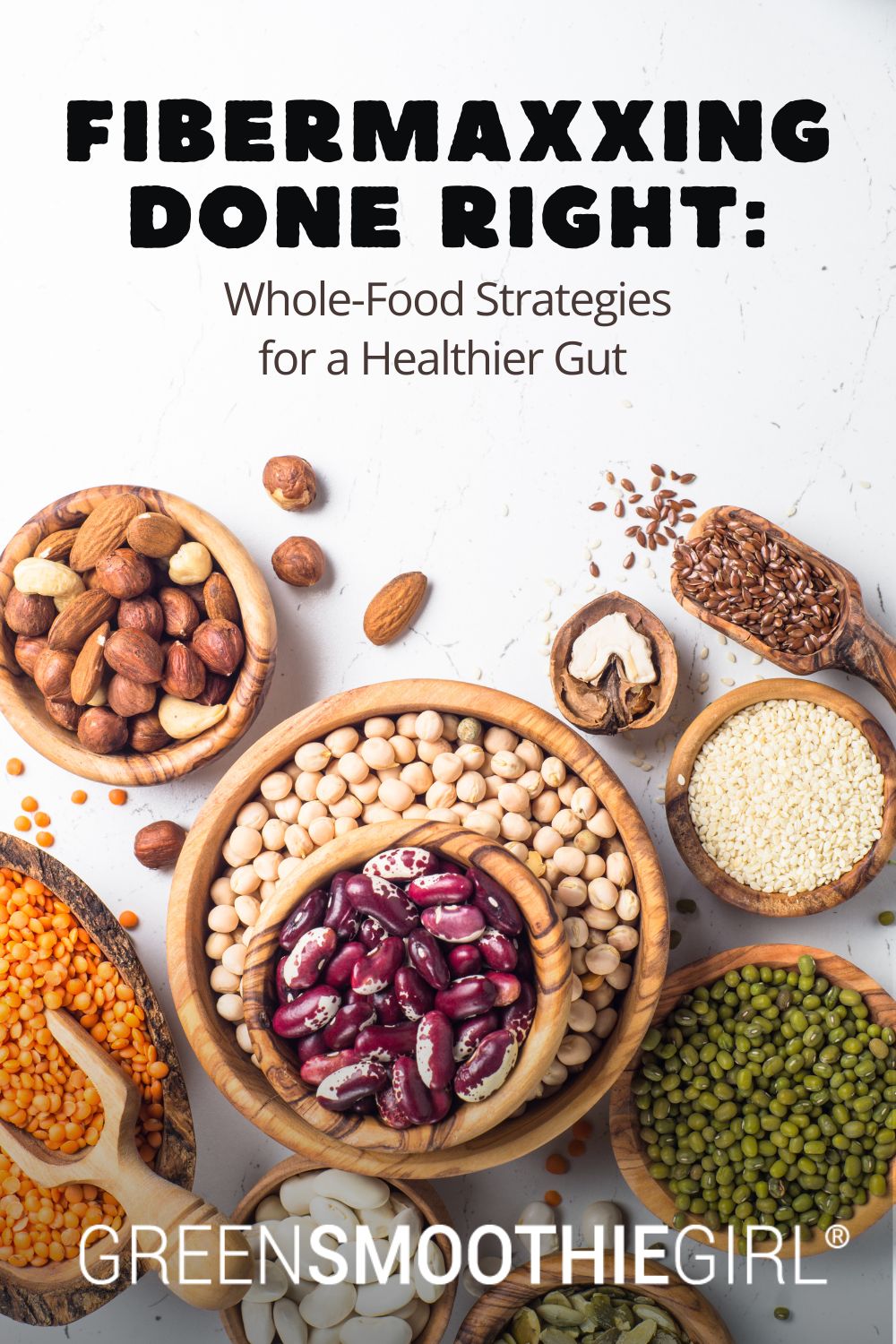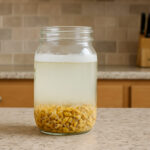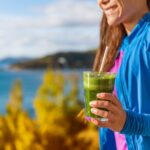Fibermaxxing Done Right: Whole-Food Strategies for a Healthier Gut

Fiber has long been hailed as a cornerstone of good health. In fact, in my opinion, fiber is the #1 deficit in the American diet.
And Metamucil doesn’t stand in for fiber in food, any more than ascorbic acid stands in for real “vitamin C,” nor a multi-vitamin pill stands in for a healthy diet. (To discover the truth about supplements, see my new book, Take Daily!)
But a new trend, dubbed “fibermaxxing,” is taking it to the next level.
From Instagram posts overflowing with chia seeds to TikTok smoothies loaded with oats, nuts, and berries, people are counting grams of fiber.
The idea is simple: more fiber = better digestion, improved gut health, and even potential benefits for heart and metabolic health.
But while fiber is essential, more isn’t always better (especially if you do it fast, and are going from a very low-fiber diet to a very high-fiber one) – and if you have a bad experience “going overboard,” you might quit fiber altogether.
Digestive discomfort, bloating, and gas can quickly turn a promising health trend into an uncomfortable experiment.
The key? A balanced, whole-food approach that emphasizes variety, gradual increases, and plenty of hydration.
Here's what you'll find in this article:
- Why does fiber matter?
- Fiber benefits beyond the gut
- Most Americans aren't getting enough fiber
- What about fiber supplements?
- Whole-food strategies to get the fiber you need
- Fiber-rich snacks
- High-fiber smoothie tips and recipes
- High-fiber lunch and dinner recipes
- Tips for digestive comfort
- Care about your gut health? Don't miss this tip!
Why Does Fiber Matter?

Fiber isn’t just roughage – it’s a vital nutrient that plays a starring role in digestive health and beyond.
There are two main types:
- Soluble fiber: This type dissolves in water, forming a gel-like substance in the gut. It helps slow digestion, regulate blood sugar, and lower cholesterol. Think of it as a sponge.
Top sources: oats, beans, lentils, apples, and berries.
- Insoluble fiber: This type doesn’t dissolve in water, but adds bulk to stool and helps food pass more efficiently through the digestive system. Think of it as a broom.
Top sources: whole grains, nuts, seeds, and most vegetables are packed with insoluble fiber.
Together, soluble and insoluble fiber support a healthy gut microbiome – the trillions of bacteria living in your intestines.
These microbes ferment fiber, producing short-chain fatty acids that feed your gut lining, reduce inflammation, and even influence metabolism and immunity.
Fiber Benefits Beyond the Gut
Getting enough fiber does more for you than you might think!
Studies show that diets high in fiber are linked to a lower risk of heart disease, type 2 diabetes, and some types of cancer.1
Emerging research is also showing that dietary fiber helps protect against the harmful effects of toxins and microplastics, which disrupt our gut health and overall well-being.2
- Binding and removing microplastics. Insoluble fibers have honeycomb-like structures that can absorb microplastic particles, reducing the time microplastics spend in the gut and limiting absorption in the body.
- Binding and removing pollutants. Microplastics often carry toxic chemicals, like heavy metals and carcinogens, on their surfaces. Dietary fiber can bind and remove these substances from the body.
- Strengthening the gut barrier. Soluble fibers help reinforce the intestinal lining, which reduces microplastic penetration into the bloodstream and potentially decreases systemic inflammation.
Fiber Truths You Need to Know
- Fiber only comes from whole plant foods. Animal products have zero, and processed foods have little to none.
- The more fiber you're getting, the more nutrients you're getting. Plus, you're crowding out the bad stuff, like processed artificial junk.
Most Americans Aren’t Getting Enough Fiber
Despite its importance, most people fall short in their daily fiber intake.
Only 5% of Americans get enough fiber in their diet, according to research.3
The Institute of Medicine recommends getting 19 to 38 grams of fiber per day, depending on gender and age.4
Ancient humans ate over 100 grams per day of fiber!5
“Fibermaxxing,” then, is essentially a response to this fiber gap – where many people have eaten mostly no-fiber animal products and processed foods for years. A trend that highlights just how essential and how challenging hitting fiber goals can be in modern diets.
What About Fiber Supplements?
If you’re looking to increase your fiber intake, it can be tempting to turn to powder and gummy supplements, like Metamucil and Citrucel, which have been increasing in popularity in the last few years.
Fiber supplements often have additives, such as artificial colors, sweeteners, and preservatives like Yellow 6, Red 40, aspartame, and sucralose. Research also reveals that microplastics have been found in all tested fiber supplements.6
Whole foods are healthier choices without additives. Plus, whole-food choices also deliver vitamins, minerals, and antioxidants along with fiber.
[Related: Why I Won’t Take 99% of Supplements Anymore]
Whole-Food Strategies to Get the Fiber You Need
Fibermaxxing done right is about incorporating a variety of whole, fiber-rich foods into your daily diet.
Here’s how to do it effectively:
1. Emphasize Beans
Legumes, like black beans, lentils, and chickpeas, are fiber powerhouses.
Add them to soups, salads, or grain bowls to boost both fiber and protein in a healthy way.
One cup of cooked black beans provides about 15 grams of fiber, nearly half of your daily goal.
One cup of cooked lentils also gives you about 15–16 grams of fiber. Plus, they are cheap!
[Related: How To Eat Legumes]
2. Go Nuts and Seeds
Nuts and seeds are excellent for adding fiber and healthy fats.
Almonds, walnuts, pecans, chia seeds, and flaxseed are all great options.
Pair them with fruit or yogurt for a fiber-rich snack that’s also satisfying.
3. Choose Whole Grains
Swap refined grains for whole grains, like oats, quinoa, barley, and brown rice.
For example, ½ cup of cooked quinoa contains about 2 grams of fiber, and ½ cup of steel-cut oats offers 5 grams. Whole grains also provide B vitamins and minerals, making them a nutrient-dense choice.
4. Pack in Fruits and Vegetables
Fruits and vegetables are versatile, tasty, and high in fiber – especially when you eat the skin.
Aim for a mix of colors: berries, apples, pears, leafy greens, cruciferous veggies, and root vegetables. A medium apple with skin provides 4–5 grams of fiber, while 1 cup of broccoli adds 5 grams.
5. Increase Gradually and Stay Hydrated
Jumping from 10 grams of fiber per day to 40 grams overnight can cause bloating, gas, and discomfort.
Gradually increase fiber by 5 grams per week and drink plenty of water, so fiber can move smoothly through your digestive tract.
6. Mix Soluble and Insoluble Fiber
Combining soluble fiber (oats, beans, fruits) with insoluble fiber (nuts, seeds, whole grains, vegetables) supports digestion and gut health, keeping things balanced and comfortable.
By focusing on variety, gradual increases, and whole foods, you can meet your fiber goals in a way that’s enjoyable and kind to your gut – turning the fibermaxxing trend into a healthy, sustainable habit.
More Tips to Increase Your Fiber Intake
- Start your day with fiber. Add vegetables, such as sweet potatoes and beans, to your breakfast. Nuts and nut butters, as well as seeds, can be added to oatmeal, toast, and green smoothies for a fiber boost.
- Pair nuts with fruits or veggies. This boosts your total fiber without overloading your gut at once.
- Keep the skin on fruits and veggies. Keep the skins on whenever possible – they are loaded with fiber.
- Stay hydrated. Fiber needs water to aid in digestion. Bonus tip: Try adding structured water to your routine for even more benefits.
One of the easiest ways to hit your daily fiber goals is through strategic snacks and smoothies.
Here are some practical ideas that are tasty, portable, and fiber-packed.
Fiber-Rich Snacks
- Apple + 2 Tbsp almond butter → ~6 g fiber
- Carrot sticks + hummus → ~5 g fiber
- Handful of walnuts (1 oz) + a small pear → ~6–7 g fiber
- Trail mix: 1 oz almonds + 1 Tbsp pumpkin seeds + ¼ cup dried fruit → ~10 g fiber
- Kale chips: Like my Dill Pickle Kale Chips ~ 2 g fiber
High-Fiber Smoothie Tips

Have you tried adding oats to your green smoothie?
- Start with fiber-rich fruits: berries, apples, pears, and bananas (with skin).
- Add vegetables: spinach, kale, carrots, or pumpkin.
- Include seeds and nuts: chia seed, flaxseed, hemp seeds, or nut butter.
- Optional grains: oats or cooked quinoa for extra fiber and creaminess.Tip: For an even creamier result, you can soak the oats for a few hours beforehand and then blend with the rest of the ingredients
- Liquid base: water, almond milk, oat milk, or unsweetened yogurt (avoid juice as the main liquid).
High-Fiber Green Smoothie Recipes
Berry Oat Power Smoothie (~15 g fiber)
- ½ cup organic rolled oats
- 3 large handfuls of spinach, or mixed greens
- ½ cup frozen blueberries
- 1 banana (with skin on)
- 1 Tbsp Sprouted Ground Flax or Tri-Omega
- 1 cup unsweetened almond milk
In a high-speed blender, blend almond milk and greens for 30 seconds. Add remaining ingredients and blend until smooth.
Green Fiber Boost (~12 g fiber)
- 1 cup spinach
- ½ cup frozen mango
- 1 small apple (with skin)
- 1 Tbsp Sprouted Ground Flax or Tri-Omega
- 1 cup water or oat milk
In a high-speed blender, blend liquid and greens for 30 seconds. Add remaining ingredients and blend until smooth.
Chocolate Peanut Butter Fiber Smoothie (~14 g fiber)
- 2 cups spinach
- 1 banana (with skin)
- 1 cup unsweetened almond milk
- 1 Tbsp natural peanut butter
- ½ cup ice
- 1 Tbsp Sprouted Ground Flax or Tri-Omega
- 1 Tbsp cacao powder
- Optional: ¼ cup oats
In a high-speed blender, blend almond milk and greens for 30 seconds. Add remaining ingredients and blend until smooth.
High-Fiber Lunch and Dinner Recipes
- Lentil-Stuffed Peppers. This is one of my favorite recipes of all time. These peppers make a quick and easy, delicious dinner.
- Lentil Tacos. This recipe is so simple. It’s much healthier than the beef version!
- Indian Green or Yellow Dahl. This easy and filling meal contains both a grain and a legume for a perfect protein-filled dinner.
- Sweet Potato Black Bean Chili. A healthy and inexpensive chili recipe to warm your family on cool nights.
- My Famous Split Pea Soup. This delicious, nutrient-packed recipe combines legumes and whole grains along with a variety of spices and veggies for a meal that will be a hit at any dinner table. It’s warm, filling, and soulful!
Tips for Digestive Comfort
- Increase fiber gradually if your gut isn’t used to it.
- Drink plenty of water.
- Ground seeds like flax or chia for easier digestion. We do this for you with our Sprouted Ground Flax and Tri-Omega Superfood (with flax, chia, and broccoli seeds). Sprouting increases the amount of naturally occurring probiotics in seeds, especially in flax.
- If you haven’t been consuming enough fiber, start with 1–2 fiber boosters per smoothie and adjust over time.
Care About Your Gut Health? Don’t Miss This Tip!
If you want to support your gut health, I recommend taking our 3-in-1 for total gut health, PreZyme Pro. A must if you have any gut issues!
We make it in small batches for freshness, so the probiotics stay alive when they get to you. We also include prebiotics – the fuel your microbiome of gut bacteria need to flourish – and digestive enzymes, plus the mineral cofactors that trigger them.
People love PreZyme Pro for a reason – it works for improving gut health. Plus, it’s an excellent daily choice for immunity and maintaining good health.
Conclusion: Max Your Fiber the Smart Way
Fibermaxxing is more than just a trendy hashtag – it’s a response to a very real dietary gap. Most people don’t get enough fiber, and increasing intake can support digestion, gut health, blood sugar balance, and overall well-being.
The key to success isn’t simply eating more fiber overnight – it’s about doing it thoughtfully, gradually, and with a variety of whole foods.
By focusing on beans, whole grains, fruits, vegetables, nuts, and seeds, and pairing fiber with plenty of water, you can meet your daily goals without uncomfortable bloating or digestive distress. Snacks, smoothies, and small meal tweaks make it easy to incorporate fiber naturally into your day.
Ultimately, fibermaxxing isn’t about numbers – it’s about building sustainable, gut-friendly habits that nourish your body and keep your digestive system running smoothly. With the strategies outlined here, you can join the fiber trend safely and deliciously, turning a popular health craze into a lifelong, gut-happy routine.

Disclosure: This post may contain affiliate links that help support the GSG mission without costing you extra. I recommend only companies and products that I use myself.

References
- Barber, T. M., Kabisch, S., Pfeiffer, A. F. H., et al. (2020). The Health Benefits of Dietary Fibre. Nutrients. https://doi.org/10.3390/nu12103209
- Wang, Huiping & Wang, Zhen & Zhang, Sijie, et al. (2024). Fighting microplastics: The role of dietary fibers in protecting health. Food Frontiers. https://doi.org/10.1002/fft2.437
- Quagliani, D., & Felt-Gunderson, P. (2016). Closing America's Fiber Intake Gap: Communication Strategies From a Food and Fiber Summit. American Journal of Lifestyle Medicine. https://doi.org/10.1177/1559827615588079
- Trumbo, P., Schlicker, S., et al. (2002). Dietary reference intakes for energy, carbohydrate, fiber, fat, fatty acids, cholesterol, protein and amino acids. (Commentary). Journal of the American Dietetic Association.
- Eaton S. B. (2006). The ancestral human diet: what was it and should it be a paradigm for contemporary nutrition?. The Proceedings of the Nutrition Society. https://doi.org/10.1079/pns2005471
- Logeshwaran, P., Haryni J., Raji, K, et al. (2024). Fibrous foes: First report on insidious microplastic contamination in dietary fiber supplements. Environmental Pollution. https://doi.org/10.1016/j.envpol.2024.125248.
Image Notes
- Fiber image used under the Creative Commons Attribution 2.0 Generic license via Flickr user formulatehealth
Posted in: Detox, Health Concerns, Healthy Weight, Immunity, Natural Remedies, Preventive Care, Whole Food
















What measures will be taken to prevent myoersonal information from being leaked whenusing services on your official website